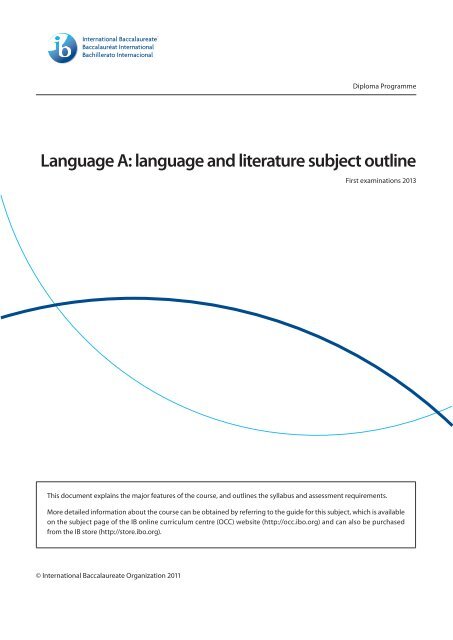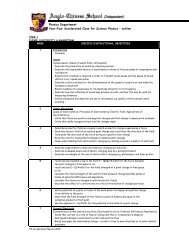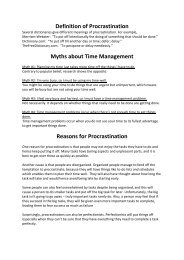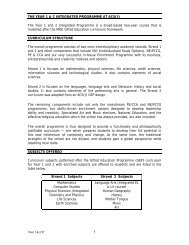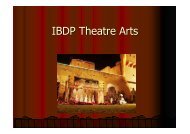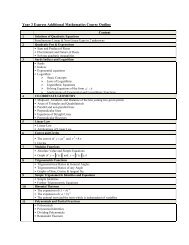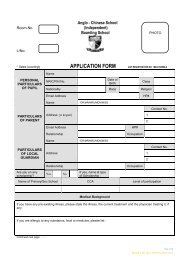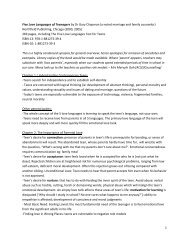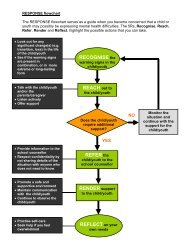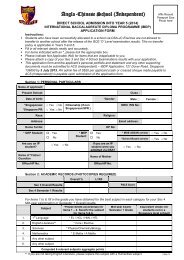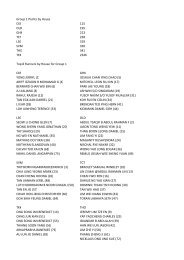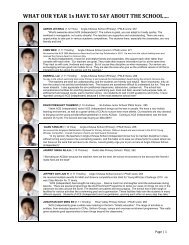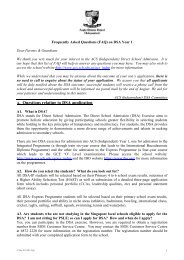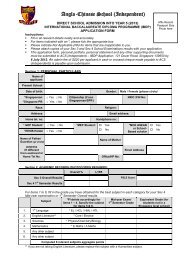Language A: language and literature subject outline - International ...
Language A: language and literature subject outline - International ...
Language A: language and literature subject outline - International ...
You also want an ePaper? Increase the reach of your titles
YUMPU automatically turns print PDFs into web optimized ePapers that Google loves.
Diploma Programme<br />
<strong>Language</strong> A: <strong>language</strong> <strong>and</strong> <strong>literature</strong> <strong>subject</strong> <strong>outline</strong><br />
First examinations 2013<br />
This document explains the major features of the course, <strong>and</strong> <strong>outline</strong>s the syllabus <strong>and</strong> assessment requirements.<br />
More detailed information about the course can be obtained by referring to the guide for this <strong>subject</strong>, which is available<br />
on the <strong>subject</strong> page of the IB online curriculum centre (OCC) website (http://occ.ibo.org) <strong>and</strong> can also be purchased<br />
from the IB store (http://store.ibo.org).<br />
© <strong>International</strong> Baccalaureate Organization 2011
Nature of the <strong>subject</strong><br />
<strong>Language</strong> A: <strong>language</strong> <strong>and</strong> <strong>literature</strong> comprises four parts—two relate to the study of <strong>language</strong> <strong>and</strong> two to<br />
the study of <strong>literature</strong>.<br />
The study of the texts produced in a <strong>language</strong> is central to an active engagement with <strong>language</strong> <strong>and</strong> culture<br />
<strong>and</strong>, by extension, to how we see <strong>and</strong> underst<strong>and</strong> the world in which we live. A key aim of the <strong>language</strong> A:<br />
<strong>language</strong> <strong>and</strong> <strong>literature</strong> course is to encourage students to question the meaning generated by <strong>language</strong><br />
<strong>and</strong> texts, which, it can be argued, is rarely straightforward <strong>and</strong> unambiguous. Helping students to focus<br />
closely on the <strong>language</strong> of the texts they study <strong>and</strong> to become aware of the role of each text’s wider context<br />
in shaping its meaning is central to the course.<br />
The <strong>language</strong> A: <strong>language</strong> <strong>and</strong> <strong>literature</strong> course aims to develop in students skills of textual analysis <strong>and</strong><br />
the underst<strong>and</strong>ing that texts, both literary <strong>and</strong> non-literary, can be seen as autonomous yet simultaneously<br />
related to culturally determined reading practices. The course is designed to be flexible—teachers have<br />
the opportunity to construct it in a way that reflects the interests <strong>and</strong> concerns that are relevant to their<br />
students while developing in students a range of transferable skills. An underst<strong>and</strong>ing of the ways in which<br />
formal elements are used to create meaning in a text is combined with an exploration of how that meaning<br />
is affected by reading practices that are culturally defined <strong>and</strong> by the circumstances of production <strong>and</strong><br />
reception.<br />
Teachers should be aware while constructing the course that the focus underpinning the approach to<br />
texts sees the study of the formal elements of each text as only one among several means of establishing a<br />
reading. As noted above, a wide range of factors, including the circumstances of production <strong>and</strong> reception,<br />
<strong>and</strong> the role of culturally determined reading practices, are seen as being equally important. A wider aim of<br />
the course is the development of an underst<strong>and</strong>ing of “critical literacy” in students.<br />
In view of the international nature of the IB <strong>and</strong> its commitment to intercultural underst<strong>and</strong>ing, the<br />
<strong>language</strong> A: <strong>language</strong> <strong>and</strong> <strong>literature</strong> course does not limit the study of texts to the products of one culture<br />
or of the cultures covered by any one <strong>language</strong>. The study of <strong>literature</strong> in translation from other cultures<br />
is especially important to IB Diploma Programme students because it contributes to a global perspective,<br />
thereby promoting an insight into, <strong>and</strong> underst<strong>and</strong>ing of, the different ways in which cultures influence <strong>and</strong><br />
shape the experiences of life common to all humanity.<br />
Prior learning<br />
There are no formal requirements for students undertaking the group 1 courses. Students who take these<br />
courses will often have varied <strong>language</strong> profiles <strong>and</strong> may be multilingual. While it is recommended that<br />
students have had experience of writing critical essays about texts, not having done so should not exclude<br />
them from studying <strong>language</strong> A. Schools should refer to the IB document, Learning in a <strong>language</strong> other than<br />
mother tongue in IB programmes, available on the OCC, for support.<br />
Each course offers the opportunity for continued <strong>language</strong> development <strong>and</strong> the acquisition of a range<br />
of skills including, for example, textual analysis <strong>and</strong> the expression of literary appreciation. The choice of<br />
the specific group 1 course will depend on the students’ <strong>and</strong> teacher’s interests <strong>and</strong> the students’ future<br />
educational plans.<br />
<strong>Language</strong> A: <strong>language</strong> <strong>and</strong> <strong>literature</strong> <strong>subject</strong> <strong>outline</strong> 1
Links to the Middle Years Programme<br />
In the IB Middle Years Programme (MYP) <strong>language</strong> A provides a balance between <strong>language</strong> <strong>and</strong> <strong>literature</strong><br />
where students develop an appreciation of the nature, power <strong>and</strong> beauty of <strong>language</strong> <strong>and</strong> <strong>literature</strong>, <strong>and</strong><br />
of the many influences on <strong>language</strong> <strong>and</strong> <strong>literature</strong> globally. <strong>Language</strong> A courses develop linguistic <strong>and</strong><br />
literary underst<strong>and</strong>ing <strong>and</strong> skills through the study of a broad range of genres <strong>and</strong> world <strong>literature</strong>, as well<br />
as <strong>language</strong> learning in context. The study of one or more <strong>language</strong>s A enables students to work towards<br />
their full linguistic potential. Gaining an underst<strong>and</strong>ing that <strong>language</strong> <strong>and</strong> <strong>literature</strong> are creative processes<br />
encourages the development of imagination <strong>and</strong> creativity through self-expression.<br />
The Diploma Programme <strong>language</strong> A: <strong>language</strong> <strong>and</strong> <strong>literature</strong> course builds on this foundation. While it<br />
is not simply a <strong>language</strong> acquisition course, it aims to ensure the continuing development of a student’s<br />
powers of expression <strong>and</strong> underst<strong>and</strong>ing in a variety of <strong>language</strong> domains.<br />
2<br />
<strong>Language</strong> A: <strong>language</strong> <strong>and</strong> <strong>literature</strong> <strong>subject</strong> <strong>outline</strong>
Aims<br />
Group 1 aims<br />
The aims of <strong>language</strong> A: <strong>literature</strong> <strong>and</strong> <strong>language</strong> A: <strong>language</strong> <strong>and</strong> <strong>literature</strong> at SL <strong>and</strong> HL, <strong>and</strong> of<br />
<strong>literature</strong> <strong>and</strong> performance at SL are to:<br />
1. introduce students to a range of texts from different periods, styles <strong>and</strong> genres<br />
2. develop in students the ability to engage in close, detailed analysis of individual texts <strong>and</strong> make<br />
relevant connections<br />
3. develop the students’ powers of expression, both in oral <strong>and</strong> written communication<br />
4. encourage students to recognize the importance of the contexts in which texts are written <strong>and</strong><br />
received<br />
5. encourage, through the study of texts, an appreciation of the different perspectives of people from<br />
other cultures, <strong>and</strong> how these perspectives construct meaning<br />
6. encourage students to appreciate the formal, stylistic <strong>and</strong> aesthetic qualities of texts<br />
7. promote in students an enjoyment of, <strong>and</strong> lifelong interest in, <strong>language</strong> <strong>and</strong> <strong>literature</strong>.<br />
<strong>Language</strong> A: <strong>language</strong> <strong>and</strong> <strong>literature</strong> aims<br />
In addition, the aims of the <strong>language</strong> A: <strong>language</strong> <strong>and</strong> <strong>literature</strong> course at SL <strong>and</strong> at HL are to:<br />
8. develop in students an underst<strong>and</strong>ing of how <strong>language</strong>, culture <strong>and</strong> context determine the ways in<br />
which meaning is constructed in texts<br />
9. encourage students to think critically about the different interactions between text, audience <strong>and</strong><br />
purpose.<br />
<strong>Language</strong> A: <strong>language</strong> <strong>and</strong> <strong>literature</strong> <strong>subject</strong> <strong>outline</strong> 3
Assessment objectives<br />
There are four assessment objectives at SL <strong>and</strong> at HL for the <strong>language</strong> A: <strong>language</strong> <strong>and</strong> <strong>literature</strong> course.<br />
1. Knowledge <strong>and</strong> underst<strong>and</strong>ing<br />
––<br />
Demonstrate knowledge <strong>and</strong> underst<strong>and</strong>ing of a range of texts<br />
––<br />
Demonstrate an underst<strong>and</strong>ing of the use of <strong>language</strong>, structure, technique <strong>and</strong> style<br />
––<br />
Demonstrate a critical underst<strong>and</strong>ing of the various ways in which the reader constructs<br />
meaning <strong>and</strong> of how context influences this constructed meaning<br />
––<br />
Demonstrate an underst<strong>and</strong>ing of how different perspectives influence the reading of a text<br />
2. Application <strong>and</strong> analysis<br />
––<br />
Demonstrate an ability to choose a text type appropriate to the purpose required<br />
––<br />
Demonstrate an ability to use terminology relevant to the various text types studied<br />
––<br />
Demonstrate an ability to analyse the effects of <strong>language</strong>, structure, technique <strong>and</strong> style on the<br />
reader<br />
––<br />
Demonstrate an awareness of the ways in which the production <strong>and</strong> reception of texts contribute<br />
to their meanings<br />
––<br />
Demonstrate an ability to substantiate <strong>and</strong> justify ideas with relevant examples<br />
3. Synthesis <strong>and</strong> evaluation<br />
––<br />
Demonstrate an ability to compare <strong>and</strong> contrast the formal elements, content <strong>and</strong> context of<br />
texts<br />
––<br />
Discuss the different ways in which <strong>language</strong> <strong>and</strong> image may be used in a range of texts<br />
––<br />
Demonstrate an ability to evaluate conflicting viewpoints within <strong>and</strong> about a text<br />
––<br />
At HL only: Produce a critical response evaluating some aspects of text, context <strong>and</strong> meaning<br />
4. Selection <strong>and</strong> use of appropriate presentation <strong>and</strong> <strong>language</strong> skills<br />
––<br />
Demonstrate an ability to express ideas clearly <strong>and</strong> with fluency in both written <strong>and</strong> oral<br />
communication<br />
––<br />
Demonstrate an ability to use the oral <strong>and</strong> written forms of the <strong>language</strong>, in a range of styles,<br />
registers <strong>and</strong> situations<br />
––<br />
Demonstrate an ability to discuss <strong>and</strong> analyse texts in a focused <strong>and</strong> logical manner<br />
––<br />
At HL only: Demonstrate an ability to write a balanced, comparative analysis<br />
4<br />
<strong>Language</strong> A: <strong>language</strong> <strong>and</strong> <strong>literature</strong> <strong>subject</strong> <strong>outline</strong>
Syllabus <strong>outline</strong><br />
Syllabus component<br />
Part 1: <strong>Language</strong> in cultural context<br />
Texts are chosen from a variety of sources, genres <strong>and</strong> media.<br />
Part 2: <strong>Language</strong> <strong>and</strong> mass communication<br />
Texts are chosen from a variety of sources, genres <strong>and</strong> media.<br />
Part 3: Literature—texts <strong>and</strong> contexts<br />
SL: Two texts, one of which is a text in translation from the prescribed <strong>literature</strong><br />
in translation (PLT) list <strong>and</strong> one, written in the <strong>language</strong> A studied, from the<br />
prescribed list of authors (PLA) for the <strong>language</strong> A studied, or chosen freely.<br />
Teaching hours<br />
SL<br />
HL<br />
40 60<br />
40 60<br />
40 70<br />
HL: Three texts, one of which is a text in translation chosen from the prescribed<br />
<strong>literature</strong> in translation (PLT) list <strong>and</strong> one from the prescribed list of authors<br />
(PLA) for the <strong>language</strong> A studied. The other may be chosen freely.<br />
Part 4: Literature—critical study<br />
SL: Two texts, both of which are chosen from the prescribed list of authors (PLA)<br />
for the <strong>language</strong> A studied.<br />
30 50<br />
HL: Three texts, all of which are chosen from the prescribed list of authors (PLA)<br />
for the <strong>language</strong> A studied.<br />
Total teaching hours 150 240<br />
<strong>Language</strong> A: <strong>language</strong> <strong>and</strong> <strong>literature</strong> <strong>subject</strong> <strong>outline</strong> 5
Assessment <strong>outline</strong>—SL<br />
First examinations 2013<br />
Assessment component<br />
Weighting<br />
External assessment (3 hours) 70%<br />
Paper 1: Textual analysis (1 hour 30 minutes)<br />
The paper consists of two unseen texts.<br />
25%<br />
Students write an analysis of one of these texts. (20 marks)<br />
Paper 2: Essay (1 hour 30 minutes)<br />
In response to one of six questions students write an essay based on both the literary<br />
texts studied in part 3. The questions are the same at HL but the assessment criteria are<br />
different. (25 marks)<br />
Written task<br />
Students produce at least three written tasks based on material studied in the course.<br />
25%<br />
20%<br />
Students submit one written task for external assessment. (20 marks)<br />
This task must be 800–1,000 words in length plus a rationale of 200–300 words.<br />
Internal assessment<br />
This component is internally assessed by the teacher <strong>and</strong> externally moderated by the IB<br />
at the end of the course.<br />
Individual oral commentary<br />
Students comment on an extract from a literary text studied in part 4 of the course.<br />
(30 marks)<br />
30%<br />
15%<br />
Students are given two guiding questions.<br />
Further oral activity<br />
Students complete at least two further oral activities, one based on part 1 <strong>and</strong> one based<br />
on part 2 of the course.<br />
15%<br />
The mark of one further oral activity is submitted for final assessment. (30 marks)<br />
6<br />
<strong>Language</strong> A: <strong>language</strong> <strong>and</strong> <strong>literature</strong> <strong>subject</strong> <strong>outline</strong>
Assessment <strong>outline</strong>—HL<br />
First examinations 2013<br />
Assessment component<br />
Weighting<br />
External assessment (4 hours) 70%<br />
Paper 1: Comparative textual analysis (2 hours)<br />
The paper consists of two pairs of unseen texts.<br />
25%<br />
Students write a comparative analysis of one pair of texts. (20 marks)<br />
Paper 2: Essay (2 hours)<br />
In response to one of six questions students write an essay based on at least two of the<br />
literary texts studied in part 3. The questions are the same at SL but the assessment<br />
criteria are different. (25 marks)<br />
Written tasks<br />
Students produce at least four written tasks based on material studied in the course.<br />
25%<br />
20%<br />
Students submit two of these tasks for external assessment. (20 marks for each task)<br />
One of the tasks submitted must be a critical response to one of the prescribed<br />
questions for the HL additional study.<br />
Each task must be 800–1,000 words in length plus a rationale of 200–300 words.<br />
Internal assessment<br />
This component is internally assessed by the teacher <strong>and</strong> externally moderated by the IB<br />
at the end of the course.<br />
Individual oral commentary<br />
Students comment on an extract from a literary text studied in part 4 of the course.<br />
(30 marks)<br />
30%<br />
15%<br />
Students are given two guiding questions.<br />
Further oral activity<br />
Students complete at least two further oral activities, one based on part 1 <strong>and</strong> one<br />
based on part 2 of the course.<br />
15%<br />
The mark of one further oral activity is submitted for final assessment. (30 marks)<br />
<strong>Language</strong> A: <strong>language</strong> <strong>and</strong> <strong>literature</strong> <strong>subject</strong> <strong>outline</strong> 7


